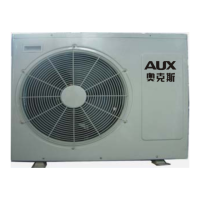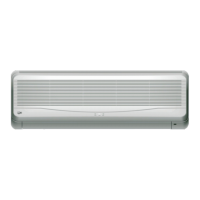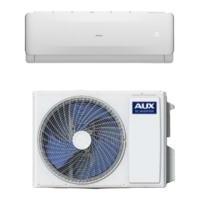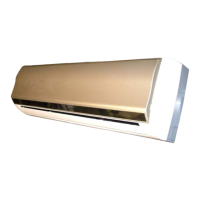AUX air conditioner service manual
capillary tubes. When the loop is not electrified, the iron core and the valve bowl move left by the
thrust of the spring. At this moment, capillary tube d and c are contacted (in high pressure), capillary
tube a and b are connected (in low pressure), thereby drive the slide of the four- way valve to move
left, and the four-way valve E will be connected with S, D will be connected with C。 When the loop
of the solenoid guiding valve is electrified, the solenoid field magnetizes the gag bit move right side,
and compress the spring for forcing the iron core and the valve bowl move right. At this moment,
capillary tube a and d are contacted (in high pressure), capillary tube b and c are connected (in low
pressure), thereby drive the slide of the four-way valve to move right, and the four-way valve D will
be connected with E, C will be connected with S.
The four-way valve consists of the valve body and four connecting pipes. The connecting pipes are
connected separately with the air-inlet and air-outlet tube of the compressor as well as the indoor and
outdoor heat exchangers. There are semicircle slide and two pistons with holes in the valve body.
Acting as the valve, the slides move horizontally inside the valve body, and have the two connecting
pipes at the bottom of the valve body to be connected through the two valve holes being covered by
the slide. The other connecting pipe at the bottom connects with the valve body through another
valve hole. The piston and the slide connect together by the valve bracket and move together in
synchronization.
When the air-conditioner runs the cooling mode, the electricity current to the loop of the solenoid
valve shuts off and the iron core drives the valve bowl to move left. Then the capillary tube d connects
to c (in high pressure) and a connects to b (in low pressure). Because the capillaries c and d connect
with the discharge pipe of compressor, they will form a high-pressure zone being filled with the
high-pressure gas. However the capillaries a and b connect with the suction pipe of the compressor,
they will form a low-pressure zone. At this moment, the piston moves to the left side by the pressure
difference, then, D connects to C, the high-pressure gas refrigerant in D pipe flows into the outdoor
heat exchanger (as condenser) for heat transmission process passing through pipe C, and enters into
the indoor heat-exchanger (evaporator) passing through capillary tube. Finally, it will enter into pipe S
from pipe E and return back to the compressor for concluding a refrigerating cycle. The flow process
is indicated in Chart 1:
24
